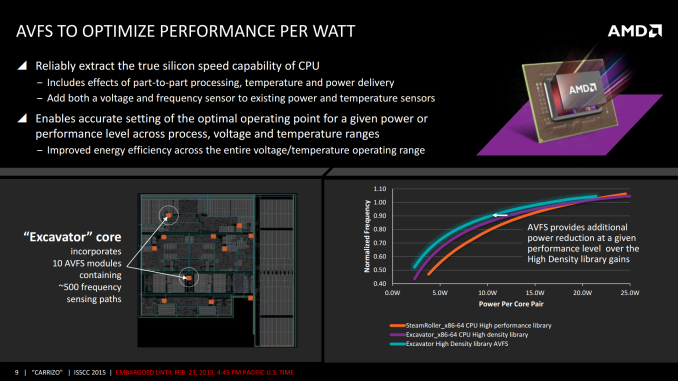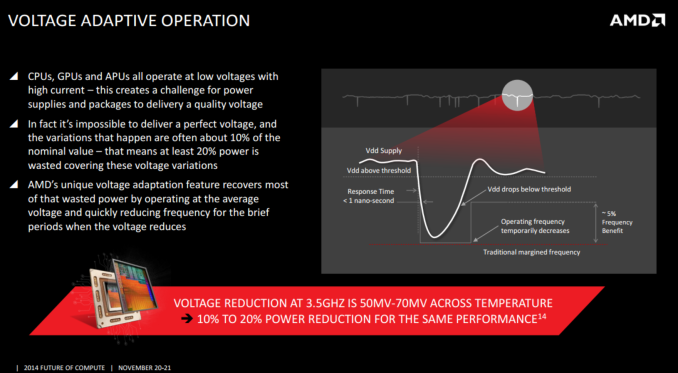AMD Launches Carrizo: The Laptop Leap of Efficiency and Architecture Updates
by Ian Cutress on June 2, 2015 9:00 PM ESTPower Saving and Power Consumption
When it comes to power, Carrizo features two/three technologies worth discussing. The first is the use of low power states, and the different frequency domains within the SoC. Previous designs had relatively few power planes, which left not as many chances for the SoC to power down areas not in use. Carrizo has ten power planes that can be controlled at run-time, allowing for what can be described as a dynamic race to sleep. This is bundled with access to the S0i3 power state, giving sub 50mW SoC power draw when in sleep and wake-up times under a second.
This is also combined with automated voltage/frequency sensors, of which an Excavator core has 10 each. These sensors take into consideration the instructions being processed, the temperature of the SoC, the quality of power delivery as well as the voltage and frequency at that point in order to relay information about how the system should adjust for the optimal power or performance point.
AMD states that this gives them the ability to adjust the frequency/power curve on a per-module basis further again to the right, providing another reduction in power or increase in frequency as required.
Next up for discussion is the voltage adaptive operation that was introduced back in Kaveri. I want to mention it here again because when it was first announced, I thought I understood it at a sufficient level in order to write about it. Well, having crossed another explanation of the feature by David Kanter, the reason for doing so clicked. I’m not going to steal his thunder, but I suggest you read his coverage to find out in more detail, but the concept is this:
When a processor does work, it draws power. The system has to be in a position to provide that power, and the system acts to restabilize the power while the processor is performing work. The work being done will cause the voltage across the processor to drop, to what we classically call Voltage Droop. As long as the droop does not cause the system to go below the minimum voltage required for operation, all is good. Voltage Droop works if the supply of power is consistent, although that cannot always be guaranteed – the CPU manufacturer does not have control over the quality of the motherboard, the power supply or the power conversion at hand. This causes a ripple in the quality of the power, and the CPU has to be able to cope with these ripples as these ripples, combined with a processor doing work, could cause the voltage to drop below the threshold.
The easiest way to cope is to put the voltage of the processor naturally higher, so it can withstand a bigger drop. This doesn’t work well in mobile, as more voltage results in a bigger power draw and a worse experience. There are other potential solutions which Kanter outlines in his piece.
AMD has tackled the problem is to get the processor to respond directly. When the voltage drops below a threshold value, the system will reduce the frequency and the voltage of the processor by around 5%, causing the work being done to slow down and not drain as much. At AMD’s Tech Day, they said this happens in as quickly as 3 cycles from detection, or in under a nanosecond. When the voltage drop is normalized (i.e. the power delivery is a more tolerable level), the frequency is cranked back up and work can continue at a normal rate.
Obviously the level of the threshold and the frequency drop will determine how much time is spent in this lower frequency state. We were told that with the settings used in Carrizo, the CPU hits this state less than 1% of the time, but it accounts for a sizeable chunk of overall average power reduction for a 3.5 GHz processor. This may sound odd, but it can make sense when you consider that the top 5% of the frequency is actually the most costly in terms of power than any other 5%. By removing that 5% extreme power draw, for a minimal performance loss (5% frequency loss for sub 1% of the time), it saves enough power to be worthwhile.













137 Comments
View All Comments
SilthDraeth - Tuesday, June 2, 2015 - link
It is sad that AMD struggles so much. I bought an HP with 1366x768, ie budget screen on most retail laptops, and an AMD A10-4600 and it plays games like Dirt 3, and stuff just fine. I haven't installed a ton of games on it. But it certainly out performs any mobile i5 or i7 that didn't have dedicated graphics card.I really hope Carrizo kicks off, and finally AMD gets some love.
meacupla - Tuesday, June 2, 2015 - link
1366x768 screens is one of the very issues that plagues AMD mobile chips.monstercameron - Tuesday, June 2, 2015 - link
So true, amd needs some kind of program to prevent oem from shipping 13*7 screens with certain socs.Penti - Tuesday, June 2, 2015 - link
1366x768 is fine in like sub 11.6-inch devices. Broadwell GT3e essentially has a stronger GPU so AMD needs to learn it's no selling point. They can't do much until they have a stronger CPU any way so both IGP and decent dGPU (switchable or whatever) makes sense with their chips. AMD chips is essentially still too weak to drive 7970m GPUs from 2012. Plus the only decent design win for mobile GCN is the new MacBook Pro 15, switchable graphics needs to be okay with Windows and Intel CPU/IGP's too. Do a shrink to 16/14 nm and make drivers that makes that happen and they should be decent enough though.BillyONeal - Wednesday, June 3, 2015 - link
1. GT3e is a 28W part; this is a 15W part. 2. GT3e is a part that costs over 3 times as much. (I'm not saying I'd buy the thing; I'm saying we need to be fair to AMD here :) )Taneli - Wednesday, June 3, 2015 - link
GT3e starts at 47W. GT3 (without Crystalwell) is available with dual core cpu in 15W (HD6000) and 28W (HD6100).Penti - Wednesday, June 3, 2015 - link
GT3 is essentially stronger without eDRAM too though.albert89 - Thursday, June 4, 2015 - link
I'd have to agree people arnt reading the stat's correctly. Broadwell beats Kaveri by a few points yet costs between one and a half and three times as much. The price of Intel APU are moving farther than the performance. And it wouldn't surprise me if Carrizo out performs Broadwell in 6 out of 10 games and that's all at 28nm !!!!!Penti - Thursday, June 4, 2015 - link
Actually when you will be able to get a Broadwell laptop (or SFF machine) for the same price, what's the point?Penti - Saturday, June 6, 2015 - link
List price for a 15W GT3 Broadwell is no more then 315 USD. Should be faster or as fast as a top-end Kaveri in game benchmarks. Is available in 370 USD NUC's barbones and soon it's in 600 dollar laptops. How much is it for a Kaveri FX-laptop? Probably a lot, and most Intel parts at least GT2+ SKU's of Haswell and Broadwell is faster than the A10 Kaveri in laptops any way. The jump from 500 to 600-700 USD just gives you a much faster notebook that's just much stronger than a Kaveri A10-device overall and even FX-7600P isn't really strong enough to game on. Carrizo doesn't really change that. AMD's numbers for 3dmark 11 on the 15W parts is on par with Iris graphics and discrete HD 7750M or 940M+ would be faster any way and is found in cheap laptops.